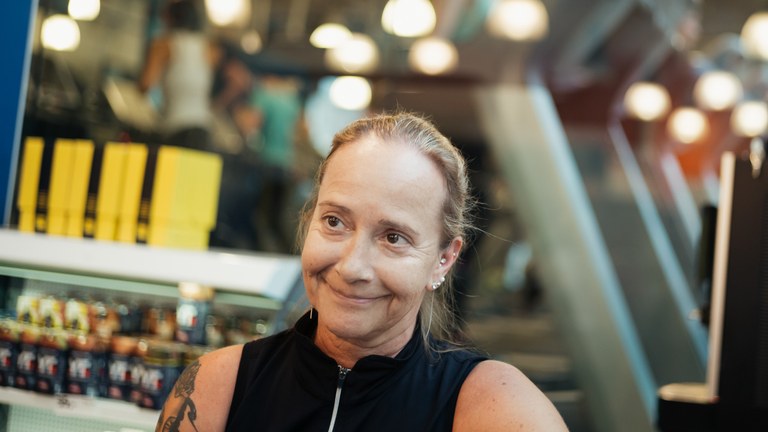Competency is a moving target, since the knowledge needed to manage a job always changes. In the fitness and exercise industry this is doubly true. Not only does one trend replace another. Competency also often means knowing the right movements and how to make people move.
It is the kind of knowledge which is hard to document. Like in other trades, there is basic knowledge which colleges and universities can teach, more trade specific knowledge and knowledge which his unique for each separate fitness chain.
“We are always looking for instructors who can inspire. They must love spending time with people and be genuinely interested in exercise,” says Grethe Stølan, a veteran in the fitness trade. She started her own fitness centre in Kristiansand in 1983, but for the past 12 years she has been in charge of exercise at at Sats Elixia Bislett in Oslo.

Fitness is a young trade. The first fitness centres in the Nordic region emerged towards the late 1950s. Back then it was mostly about lifting heavy weights and strong men. 1982 saw the aerobic wave. The number of fitness centres in Norway rose to nearly 400.
“Personally I have been doing this since Jane Fonda, but today aerobic is just a small part of the business,” says Randi Christensen, who has the overarching responsibility for recruiting group instructors to all of Sats Elixia’s Norwegian centres.
A dip during the 90s
In the early 90s the entire trade went through a dip, but gained new energy as spinning became popular.
In recent years, yoga has become a big thing.
“I call it a tsunami, it just keeps on growing. There has been a split in the fitness industry, where one side focusses enormously on what is known as High Intensity Training, where you train at a maximum rate for 30 to 40 minutes. Build’n burn, as we call it.
“But that again creates the need for recovering. You could say that all of society has chosen the High Intensity wave. The more who do many things at once, the greater the need for yoga,” says Randi Christensen.
Sats Elixia sprang out of the merger between the fitness chains Sats and Elixia in 2013. They are part of Health & Fitness Nordic (HFN) which in turn is owned by the Norwegian venture capital firm Altor (51 percent) and the Danish insurance company Tryg (49 percent).
Sats Elixia is now the largest chain in the Nordic region, with 160 fitness centres, more than 8,000 staff (2,000 full time positions). The chain has 418,000 members and a turnover of 2.6 billion Norwegian kroner (€278m).
Licensed education
Randi Christensen says Sats Elixia needs 70 to 100 new instructors every year, to work both with groups and as personal trainers. They also need 100 yoga instructors. That makes 200 people in total per year, only in Norway.
The training is a mix of public and private input. The Norwegian School of Sport Sciences offers a fitness course, but there is also a private school, Safe Education. This was originally founded by Swedes, but is now owned by the same companies that own Sats Elixia.
“At Safe you get a licensed education. Your license allows you to go to work for other fitness centres too, not owned by Sats Elixia.”
Yoga instructions train at a different institution, Hiyogas teacher training.
“I help pick those we feel fit well by organising recruitment fairs. Before running a fair, we advertise this quite broadly, also in social media. Many have also been members with us earlier,” says Randi Christensen.
“If you have been chosen by us, we pay for all the instructor education. Some of those we do not want to hire, take the courses themselves. In that case they have to pay 15,980 Norwegian kroner (€1,711). We also sometimes agree to partially sponsor the education.”
What is the next trend?
"After the merger, Sats Elixia offers 120 different courses. Many are quite similar, so it is more about harmonising them and getting the number down, rather than launching new courses right now.”
She travels to trade fairs to check out the latest trends herself.
“Anyone selling equipment develop new group sessions. Step machine companies for instance. But we have found out that we develop new types of basic training best ourselves,” says Randi Christensen.
Hot yoga has become popular at Sats Bislett.
“We have a room where the temperature is 38 degrees centigrade,” says Grethe Stølan.
What will training look like in ten years from now?
“It will probably be much the same. People like to train together at set times. But the training will probably become even more functional. It is important to exercise the entire body as efficiently as possible in 30 minutes,” she says.
- The Nordic region is a fitness leader
-
The Nordic countries are top in Europe when it comes to how much of the population are members of a fitness centre. In Norway the number is 19.4 percent, in Sweden 16.7 percent and in Denmark 15 percent. Only the Netherlands can compete, with 16.4 percent of the population being members of a fitness centre, according to Deloitte’s annual survey.
The ‘fitness industry’ has grown faster than most industries. In Europe 55 million people are now members of a fitness centre. The need for group instructors, personal trainers and yoga instructors is massive.
There is still room for growth. According to a healthcare report commissioned by the Nordic Council of Ministers, only 32 percent of the adult population in Norway move as much as they ought to.
 Follow us on Facebook
Follow us on Facebook
